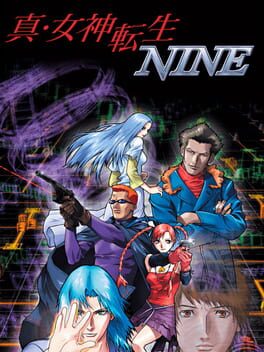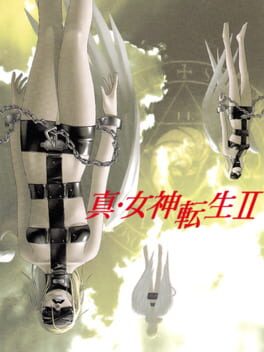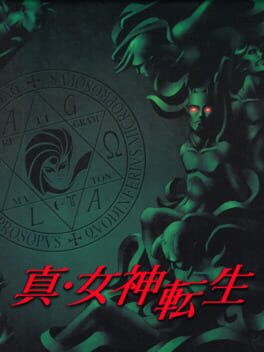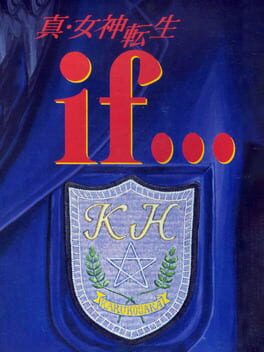

Fifty years have passed since the hero of Shin Megami Tensei followed the neutral path, defeated the leaders of Law and Chaos, and founded a state where followers of both ideologies could live freely. But his reign of freedom doesn't last long. The Messian faith gains power, expanding the Cathedral into a new enclosed environment named Tokyo Millennium. The Gaians rise up, but their rebellion is repressed by the Messians' elite warrior class, the Temple Knights. People flock into the encapsulated city, submitting themselves to the strict hierarchy imposed by the Messian Center, where only the privileged living in the Center district are safe from demonic assaults. A few years later, a retired arena fighter Okamoto rescues a man named Hawk, who was fighting for his life against a demon. He trains him to fight in the arena of the Valhalla district, hoping that he would win the tournament, which will grant them both citizenship in the Center district. When Hawk succeeds, he is brought before a Messian bishop, and learns the shocking truth about his own origins and the role he is supposed to play in the grand scheme of events. A new battle for a better future begins. Shin Megami Tensei II retains all the gameplay features of the previous game. The player is able to summon demons, fuse them to create more powerful ones, make them participate in battles, talk to random enemies and receive information from them, etc. The combat is turn-based, and the player explores the complex, maze-like dungeons from a first-person perspective view. Like in the first game, the Law, Chaos, and Neutral alignments play an important role: during the course of the game, the player will have to make choices that influence the alignment of the protagonist, steering the storyline into different directions. New features include a "magic succession" system, which allows demons to carry over their original magic spells when they are fused into new ones, a few additional spells and abilities, and the possibility to play at the casino and win unique items.
Also in series
Released on
Genres
Reviews View More
This review contains spoilers
On the other hand, good god does backtracking in the later part of this game become a nightmare. The last terminal you get access to is quite a ways away from the final part of the game, so if you want to finish up, make sure you have EVERYTHING you want, cause you're strapped in.
All in all, I really wish Atlus went back to this type of game, cause it's pretty cool.
Shin Megami Tensei 1 was about a world ending and moving forward after it does. SMT 2 is some weird sci fi post apocalypse typical of Japanese media at the time of its release. I personally felt much less immersed in this world than I did in the first, and I'll admit, I do not know why.
I recognize that while it does do some efforts to convey its unique world to the player, I really did not get into it at all while I completly did with the first. I did not feel it was worth going through when I reached the point where I needed to boost a completly useless stat to progress the story.
I think the point I'm trying to make is that I keep comparing this game negativly to the first when the first is by no means a masterpiece, it's a janky 90s RPG that aged very badly, but I found something in it that I simply did not for this one.
SMT2 came out a couple years after the first SMT and takes a pretty different approach to the narrative compared to the first game. This is a direct sequel to the first game, taking place some time after the neutral ending of SMT when Law has managed to take nominal control over society again. The followers of Law have built a massive pyramid-like city high above the ruins of old Tokyo called MILLENNIUM TOKYO, and that's where you, Hawk, live. You're a prize fighter about to engage in the championship bout to meet the heads of state at the Center as your prize. From there, you end up going on missions for the Center, even going as far as being claimed the Messiah after defeating the anti-Messiah in a huge staged fight, but that's when things really start to go off the rails and its revealed that (of course) things are not even close to the way they seem.
I'm of a split mind about SMT 2's story. On one hand, it's a bold step forward for character writing and a character-driven plot compared to the first game. On the other hand, the story is much less open and much more directed the first game's, but this game also keeps the same alignment system that the first game has. It results in a game where trying to get the ending you want is a lot more frustrating mechanically and a fair bit less appropriate narratively because of how the story is constructed. It isn't quite Megami Tensei 2 in how structured the story is, but it reminds me more of that game than it does of Shin Megami Tensei 1. There are some other smaller things I'm not a fan of, like how this game has significantly more homophobia in it than the other SMT games I've played (though that isn't exactly unique for Atlus games these days), but I'd still rank this game below its predecessor in terms of narrative. It's a good step in the right direction for making a more complicated and relatable version of the kinds of themes that SMT 1 is trying to talk about, but it still definitely needs polishing up in making the player feel like it's a world with more equally valid arguments to agree or disagree with.
The gameplay is a very similar to the first game in that it's first-person dungeon crawling with turn-based battles where you can fight or recruit the demons you run into, but like with the writing, this is another mixed bag of new improvements but setbacks to previous features. On the good side of things, you have now L is now a shortcut to your auto-mapper and R a shortcut to your demon analyzer, as well as the very significant ability to actually see what items and spells do in-game rather than needing to look them up like you had to for SMT 1. The most significantly appreciated step forward is in regards to demons and how they're no longer all completely identical. They're all still mostly identical, sure, but now if you make a demon via fusion of two other demons, they can inherit some spells from what they were fused from. It's not a massive change, but it's another very good step in the right direction that future games would follow.
The list of negative changes is unfortunately much larger. While the concept of alignment is still around, and it's still decided by story-important decisions you make (both optional and non-optional) and determines if you can equip certain items and recruit certain demons, you can now no longer check your alignment by which way your cursor spins on the world map. Now the only way you have to check it is by trying to summon demons of the presumed opposite alignment (law can't summon chaos demons and vice versa) or trying to equip some of the very small number of alignment-locked equipment. The signposting is also much worse, with it generally being much harder than in the first game to know where to go or what to do (particularly around collecting the very well hidden 7 pillars).
Random encounters have been lowered, sure, but they also give magnetite less frequently and they give less of it. You need magnetite to keep demons summoned, so a shortage of magnetite is a really bad thing to have, and there were several points where I had to spend large parts of the game either with no demons summoned or just grinding for magnetite because running out of it is such a huge problem. This is compounded by the fact that the way demon negotiations (to recruit them) have been significantly altered. They're more dynamic and conversational, sure, but it's also much harder to get anything out of them that isn't friendship. In the first game, you could very easily ask them for money, magnetite, or items too, but that isn't the case in this game. You can almost never explicitly ask them for things, and when they do give you money or magnetite, it's very small amounts. They thankfully also only ask for super small amounts of money/magnetite if they're demanding it in negotiations, but that really doesn't help much when you're already so short on magnetite.
Game balance is also similarly bad to the first game, with a typically brutal early game and a more easy mid-/late-game, but the final bosses are thankfully nowhere near as much of a cakewalk as they were in the first SMT. Like in SMT, guns and bullets that either sleep or charm enemies are going to be your biggest friends. Sword fusion is also much harder to do in this game, so it's much harder to rely on that for an easy super weapon like you could in the first game. I myself really lucked out by finding Fargus's Sword in the mid game, one of the game's best weapons that's a rare random drop, but without that I would've had a MUCH more difficult time. Leveling up still works the same, with putting one stat point into a stat (strength, intelligence, magic, vitality, speed, or luck) per level, so leveling up is still an exercise in very gradual power growth, so getting stronger demons or finding better equipment are still going to be your best options for dealing with encounters you simply can't beat.
However, the biggest reason for this difficulty spike isn't any of that, or even the dungeon design (which is still pretty damn mean in terms of invisible pitfalls, floor traps, one-way doors, and even more difficult to see in darkness). The biggest issue with SMT2 is the way the allied AI has been ruined. In SMT 1 and SMT 2, the way random encounters work is that you run into one or two demons at a time who each have several members of their group (from 1 to 8). However, although you can pick which demon group to attack, you can't specify which of the 1 to 8 you wanna hit. In SMT 1, your AI are pretty damn good at focusing down weakened members and avoiding trying to bash enemies who are slept or stunned. In SMT 2, that intelligence is robbed from them entirely, and they seem to attack things almost at random. This makes the game much MUCH harder in its random encounters compared to the first game, and that's an issue that persists the entire game (especially as you get more and more enemies who are totally immune to guns, which are your main and most effective way of dealing status effects in a game where MP is still such a valuable and difficult to recover resource).
The presentation is one area where it's a universal step up from the first game. Dungeon tile sets are much prettier, and although there are a lot of returning demons, virtually all of them have been touched up or altered in some way. There's a lot of new, good music too, but it's still in the much more low-key and atmospheric style of the first game. Good music, but not really my jam. You can REALLY feel just how much Atlus had gotten more comfortable with the Super Famicom's hardware in the two years between the first game and this one.
Verdict: Hesitantly Recommended. This is a much more hesitant recommendation than the first SMT. It's virtually impossible to recommend not playing it with rewinds and save states like I did, but it's such a step down from the first game in so many frustrating ways that you're much better off playing that instead. Now if you really like SMT 1 and want more of that, then SMT 2 is a pretty good way to get it. Just don't expect this to be quite as polished or refined an experience as that.





